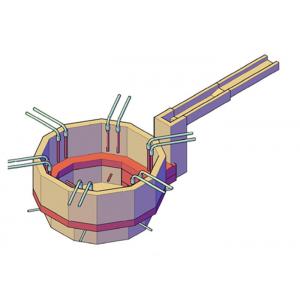
Add to Cart
Electricity Flue, Electric Glass Furnace, High Melting Rate Furnace
1. Brief Description
Glass was used for windows and doors by the Ancient Romans as early as the 4th century.
In 1902, Voelker was granted a basic patent for melting glass using the heat generated by an electric current through the batched material. Under the continuous development and improvement of the furnace design technology and electrode, this electric melting method is extensively used.
Between the year 1920 to 1925, Raeder from Norway used graphite electrode for furnace, which has successfully achieved a fully electric furnace.
In 1925, Corneljus from Sweden took this kind of electric furnace to produce amber glass and green glass. The electric melting furnace adopts the method of blanket charging and the batching material floats on the surface of glass liquid
Glass is an electric conductor under high temperature. There are alkali metal and potassium ions in melted glass liquid. These two ions have conductivity, when the electricity through the glass liquid, the joule heat will be produced, if there is enough calories produced, it can melt the glass, which is called “Glass Electric Melting”.
Glass liquid forming
In this stage, the sinter will be melting and the silicate and SiO2 in sinter will change to flint glass liquid with a plenty of bubbles. However, its chemical components and character are not even.
Clearing
The glass liquid is continuously heated, and its viscosity is reduced with plenty of gaseous sundries released, which should eliminate the visible bubbles with the pool of liquid.
Homogenization
The glass liquid is kept at high temperature for a long time, the ripple eliminates by diffused function and homogenizes as a whole. The temperature of homogenization can be lower than the clearing stage.
Glass melting is a very complex process, it includes physical, chemical and physicochemical phenomena and reaction. These phenomena and reaction lead the mechanical mixed raw materials to complex melting glass liquid.
3. Furnace structure
| Item | Description |
| 1 | Melting tank |
| 2 | Throat |
| 3 | Forehearth |
| 4 | Spout |
4. Melting section of electric furnace
Using cooling top vertical melting type theory, which will concentrate the melting process. The design of melting area is benefited for glass melting and homogenization, no death zone in melting scope, that will ensure the melting efficiency of glass materials and clarification, producing high quality glass liquid.
Adopt electric fused cast AZS materials for melting and non-melting areas, clay brick, light clay insulation brick and aluminum silicate products for other parts.